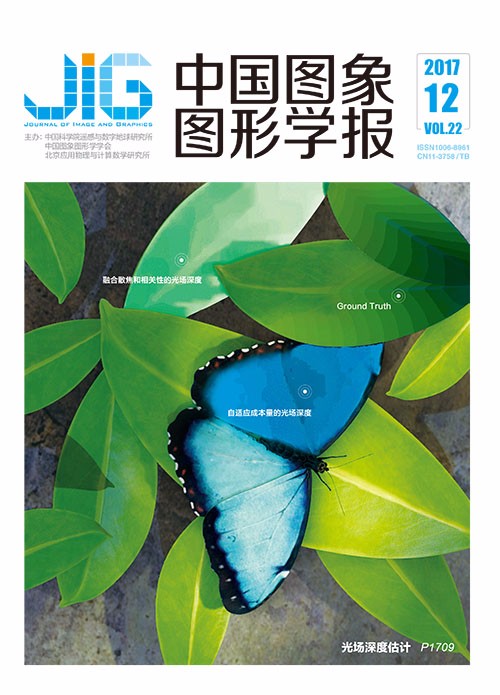
血液红细胞图像自适应标记分水岭分割算法
王娅(南京理工大学泰州科技学院基础部, 泰州 225300) 摘 要
目的 显微细胞的精确分割是计算机辅助诊断的前提和关键,为精确分割含有粘连重叠红细胞及病变红细胞的彩色显微图像,基于HSI模型,提出了一种自适应标记分水岭分割算法。方法 首先结合红细胞无核特点提取反光细胞的中心,从图像的S与I分量的梯度图中提取图像前景低频成分的局部极值点,两部分相结合作为初始标记,标记细胞前景;然后根据标记特点去除伪标记点,以确保所有粘连细胞的重叠区域不被标记;接着采用主成分分析从S与I分量梯度图中提取梯度信息重构梯度图,最后结合背景标记,应用标记分水岭变换实现分割。结果 选取美国社会血液学数据库中含病变和粘连的红细胞图像进行分割实验,采用平均欠分割率、平均过分割率、平均准确率3个指标对分割结果进行评价。本文算法的欠分割率为2.23%,过分割率为1.67%,均明显低于文献中两种现有分水岭算法;分割精度高达96.10%,准确度高;平均运行时间6.06 s,可保证一定的时效性。结论 提出了一种对病变粘连红细胞彩色图像的分割算法,利用饱和度与亮度信息,自适应地标记出前景细胞,提高了分割精度;采用主成分分析法,更好地保留了重叠细胞的原有边界。算法具有较好的鲁棒性,可广泛用于包括血液红细胞在内的含有类圆形的重叠、粘连细胞的显微染色图像的分割。
关键词
Adaptive marked watershed segmentation algorithm for red blood cell images
Wang Ya(Department of Basic Science, Taizhou College of Nanjing University of Science and Technology, Taizhou 225300, China) Abstract
Objective Accurate segmentation of the microscopic cell image is the premise and key of computer-aided diagnosis. However, microscopic images of red blood cells always contain images of strongly adherent, overlapping, and pathological cells, thereby bringing difficulties in accurate segmentation. This study proposes an effective algorithm based on watershed transform to segment these cells in the HSI space. The segmentation accuracy of cell images is improved by adaptively marking the foreground and background areas and reconstructing the gradient maps. Method The marked watershed transform algorithm is widely used in the segmentations of microscopic cell images because of its simplicity and efficiency. The key to the effectiveness of the algorithm is to accurately mark the foreground cells. However, the presence of strongly adherent, overlapping, and pathological cells seriously affects the accuracy of the markers. To overcome this problem, this study adopts low-pass filtering and proposes an adaptive heuristic algorithm. The proposed algorithm marks the reflective center regions of red blood cells due to non-nuclear characteristics and finds the cytopathic regions from the change in the saturation of pathological cells. Thus, the interference of texture changes in cells caused by uneven illumination and cytopathic regions on segmentation is reduced. Then, in the HSI space, the local extreme points of the low-frequency component are extracted from the gradient maps of the S and I components. The two parts of the reflection regions and the low-frequency extreme points are combined as the initial markers to mark the foreground of image. Thereafter, the pseudo markers are removed in accordance with the different features of these marks to ensure that the overlapped regions of adherent cells are not marked. After obtaining the foreground markers, the background markers are derived from the binary image through morphological operations. Subsequently, a modified gradient map is reconstructed using principal component analysis to extract the information from the S and I components of the gradient map and thus suppress the abnormal gradient value and obtain highly detailed gradients. The reconstructed gradient map retains considerable gradient detail and reduces the noise interference. Finally, the marked watershed transform is applied to the reconstructed gradient map, and image segmentation is realized. Result An experiment for verifying the effectiveness of the proposed method is conducted. Four types of red blood cell images containing images of strongly adherent, overlapping, and pathological cells from the American Society of Hematology database are utilized for segmentation. Experimental results are quantified through three indexes, namely, average less-segmentation rate, average over-segmentation rate, and average accuracy, in objectively evaluating the performance of different algorithms. The first two indexes of the proposed algorithm are 2.23% and 1.67%, which are significantly lower than the results of the two other watershed algorithms in literature. The segmentation accuracy is as high as 96.10%. The segmentation performance of the proposed algorithm is better than that of the two other algorithms. With regard to timeliness, the average running time of the proposed algorithm is 6.06 s compared with that of the two other algorithms. Conclusion This study proposes a segmentation algorithm to colored images of red blood cells containing images of strongly adherent, overlapping, and pathological cells. The strongly adherent and overlapping cells can be marked adaptively and accurately by taking advantage of the saturation and brightness information from the S and I components in the HSI space. The principal component analysis can effectively preserve the original boundaries of the overlapping cells. This adaptive marked watershed algorithm not only can separate strongly adherent and overlapping cells but also can effectively suppress the influence of the shape and internal nature of pathological cells on the segmentation. The segmentation results of the proposed algorithm are outstanding in terms of either the accuracy of cell count or the preservation of cell morphology. The performance of the algorithm is insensitive to cytopathic regions and possesses good robustness. This algorithm can be widely used in the segmentation of microscopic staining images with round overlapping and adherent cells as well as blood red cells.
Keywords
marked watershed transformation hue-saturation-intensity (HSI) model low-pass filtering princical component analysis (PCA) cell image segmentation
|



 中国图象图形学报 │ 京ICP备05080539号-4 │ 本系统由
中国图象图形学报 │ 京ICP备05080539号-4 │ 本系统由